Southern Hills Country Club: Perry Maxwell’s Crown Jewel
by Chris Clouser
During the Great Depression that covered the time frame of the 1930s, only a handful of great courses were designed around the country. The majority of these were touched in some way by Perry Maxwell during that period. Perhaps his largest project during that time frame was at Southern Hills in Tulsa, Oklahoma. The construction of the project took place over two years from 1935 and into 1936. The construction of the course saw many ups and downs. There were issues with getting the project underway at all, but once the final amount of funding was secured and the land donated by local philanthropist Waite Phillips the design was begun. The only conditions on Phillips donating the land were that Perry Maxwell be the designer of the course and oversee the construction.
The construction of the course used up to 500 people on the site at one given time according to reports from Press Maxwell later in his career, which was funded by the WPA. Several men oversaw the large crew, including Press, Dean Woods and Wendell Miller. Wendell Miller actually died on the site due to a heart attack during construction. How involved was Perry Maxwell in the project? He, Press and Dean Woods stayed on the site and lived in tents during the construction of the course. How often does that happen in this day and age?
The original design intent of the course was to be the caliber of those holding national championships and to bring top-level tournaments to Tulsa. Maxwell succeeded with his ‘Crown Jewel’ and the course has seen several USGA Championships, including three US Opens, two PGA Championships and other top-flight tournaments over the years. The impact of Southern Hills though is not only felt on the tournament level, but also by its influence in an architectural sense. Since the completion of the course, every course in Oklahoma has been held up to the standard of competing with Southern Hills, so it has been somewhat copied in style all across the state. It wasn’t until Pete Dye’s work at Oak Tree in the mid-80s that another style even registered with the critics around the state. Due to its history and influence, Southern Hills is truly a course worthy of discussion and study.
Holes to Note
Hole 1: 464 yards
As with most of Maxwell’s courses he featured an elevated tee that provided an excellent view. The first here does not disappoint as the Tulsa skyline is in the distance. The elevated tee shot of almost 60 feet also makes the hole play shorter than many would suspect. The subtle roll in the fairway also should not be lost on the player as the correct tee shot will draw off of the bunkers on the right and provide a clear view into the tightly bunkered green that appears to fall off behind the green. Another strong characteristic of Maxwell opening holes is they often provide an excellent introduction to the course and this is no different. From behind the green though it is apparent that trees added inside the cart paths around the course have tightened the course and have eliminated some avenues of play.
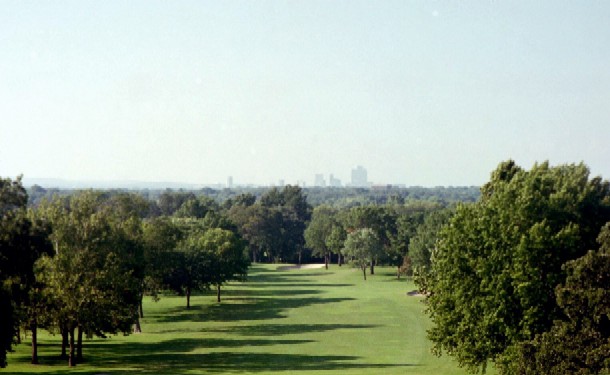
The view from the elevated 1st tee.
Hole 2: 471 yards
Though this hole is similar in length the player does not benefit from the elevated tee and also plays into the prevailing wind from the southwest. This tee shot is perhaps the most difficult on the course as it must not only clear the creek and bunkers but make it through what appears to be a narrow chute of trees. The narrowness is exaggerated by the position of the trees near the tee box, but the difficult carry is still there for the every day player. The green is located just short of another part of the creek. Again subtle undulations in the terrain rule, as the slight slope from the right for the approach affects the lie of anyone hitting onto the square shaped green. These two opening holes provide a difficult test for any golfer. Much has been made about tree growth affecting this course over the years. The 2nd hole is perhaps one example of that. The left side of the hole short of the creek was a valid option for shorter hitters because they could still hit their second short of the green and be relatively close enough to pitch and putt to save par. That option has been almost eliminated due to a decrease in fairway width on that side and the intrusion of trees along the left side of the hole beyond the creek. It is possible that this hole was designed as an offspring of the ‘Bottle Hole’ concept from CB Macdonald with the creek serving as the carry hazard instead of bunkers. But to appropriately have this design in place the green needs to be open from the left much more than it is currently.
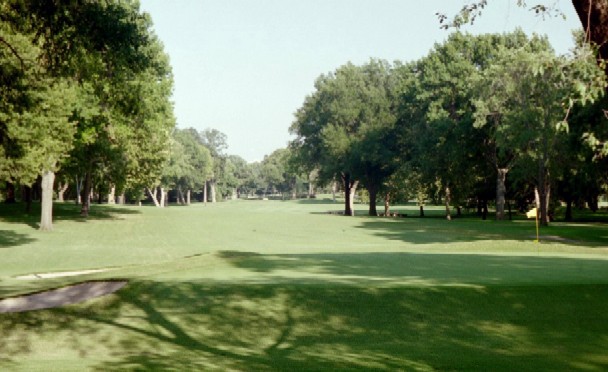
A view back down the narrow and demanding 2nd hole.
Hole 3: 410 yards
This is perhaps the most photogenic hole on the course and provides a nice reprieve from the opening duo of difficult monsters. The landing zone is ample, but the true test on the hole is the green. Any approach must clear the creek that runs short of the putting surface, but this should not concern many unless they hit their tee shot into the rough. The slope and contours of the putting surface leave a difficult putt regardless of pin position.
Hole 4: 372 yards
The elevated green in the distance was the only alteration that Maxwell made to the course after it opened. He moved it further up the hill. It is believed he did this fairly early in the course’s life. The landing zone for the drive rolls dramatically down into a valley and provides an extremely testing short iron up hill and with the ball below the player’s feet. The bunkering around the green is tight against the putting surface and can be used to provide some extremely difficult pin positions.
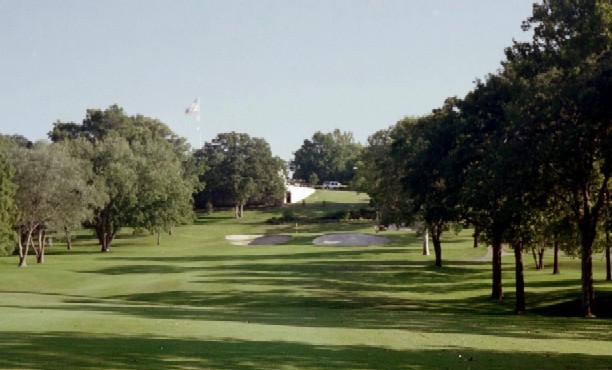
Maxwell's 4th green is benched into the far hillside.
Hole 5: 655 yards
When Robert Trent Jones visited the course before the 1958 US Open he said, ‘You’ve got one of the best courses in the world here. You’d be a fool to let anyone touch it.’ So Jones decided that he only needed to do minor adjustments to the course. The 5th is perhaps the one hole he touched more than any others. He created a back tee that has since been extended and added some fairway bunkering on the outside of the dogleg. Shortly after the Open, most of his changes were eliminated but these remain today. The length alone of this hole makes it difficult, but if the player can clear the bunker on the inside of the dogleg then the hole opens up considerably. The terrain up by the green flows from left to right and the player that can hug the left side of the fairway has a much more open approach to the green. But woe to anyone caught in the left hand bunkers. The green rolls away from them and makes any up and down almost impossible.
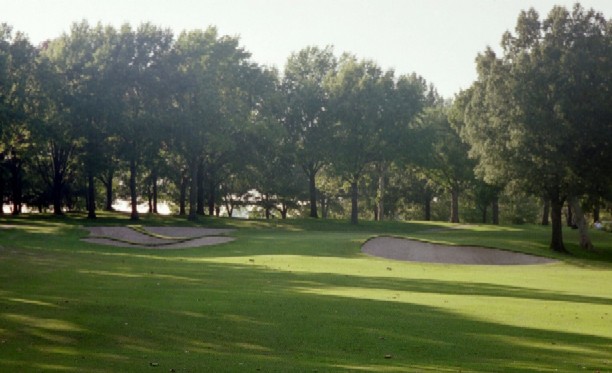
The 5th.
Hole 6: 178 yards
The first par three on the course and also the most appealing to the eye. It appears both beautiful and easy. The former is accurate, the latter is anything but. As with most of Maxwell’s courses he routed his par threes to go in all directions on the compass. This one runs northward and the prevailing breeze blowing from left to right. The water on the hole is only in play for the pulled or hooked shot, but the green is the real defense as a false front and large roll in the green make it a difficult birdie.
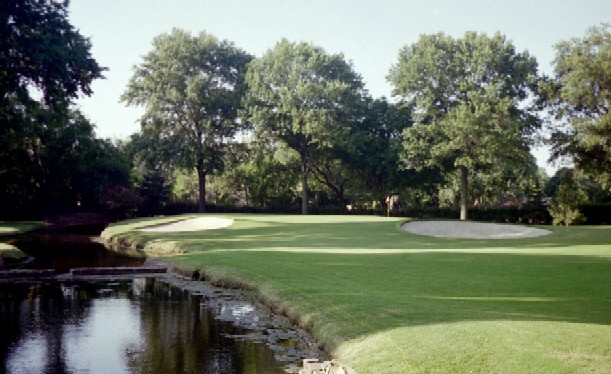
The tranquil beauty of the 6th.
Hole 7: 384 yards
This is the second hole that has seen dramatic changes since it’s opening. The green was moved after the 1958 Open by Floyd Farley due to drainage and air circulation issues. It was moved approximately 20 yards away from the creek. The green does stick out from the others on the course as it does not integrate into its surrounds nearly as well as the others on the course as can been seen when viewed from behind the putting surface. The tee shot goes over a rise in the fairway that can be used to run the ball down into the swale short of the green and provide a shorter approach. The rise on the left side also at one time contained a bunker that had been filled in over the years. It is evident why Maxwell picked the green location he did as any approach to the location would have been downhill, where today it is almost level. The 7th green is another difficult green much like the rest of the front nine.

Maxwell's bunker is no more at the 7th.
Hole 8: 228 yards
This long par three was called by many in the ’58 Open as the toughest they had ever played. This Maxwell version of the Redan was a ‘template’ hole that he used on several courses over his career and this seemed to be his preferred distance for the hole. The green is protected by two large bunkers short and on the right and it flows beautifully off of the knoll on the right. The green definitely flows from right to left off of a ridge about a quarter of the way into the green. This same style of hole was originally used at Dornick Hills and later at Old Town by Maxwell.
Hole 9: 374 yards
On the card this hole appears to be a short to mid-length par four but it plays dramatically uphill to the elevated green surface. The unknowing player will see a green in the distance, and possibly decide on his tee shot strategy based on the pin location, but the green they see is actually the 18th. The proximity of the greens to one another was a coy play by Maxwell that he used in trying to fool the players. He borrowed this concept from his study of the Old Course at St. Andrews and used it at other courses as well. This is one example where the trees that have grown on the property have actually helped the architect’s original intent as the ninth green is hidden from view until the player begins walking up the hole. The proper play on the hole is over the bunker inside the dogleg. The green is one that provided fits to many of the players in the 2001 US Open because of the speed it was being maintained at. It didn’t allow them to shoot directly at the pin and forced many of them to play to the safe middle of the green without their usual backspin on the ball.
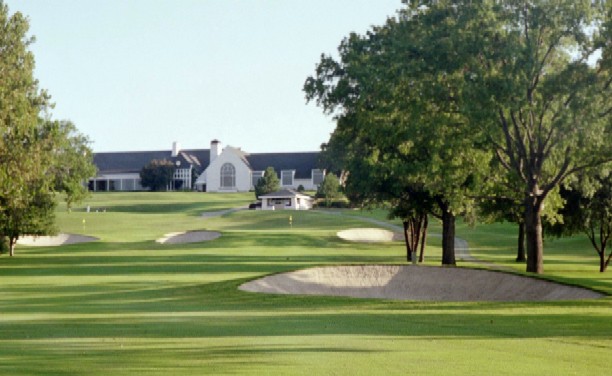
A tee ball past this bunker leaves the golfer with the best approach shot into the 9th.
Hole 10: 369 yards
The elevated tee to the opening hole of the back nine welcomes the player into what many consider one of the toughest nine hole stretches in championship golf. This group of holes take up the part of the site that uses the roughest part of the terrain and provides the famous sloping fairways of Southern Hills. The fairway at 10 is perhaps the narrowest on the course as the slope runs dramatically from right to left off of the hill that the clubhouse sits on. Then Maxwell cleverly forces the player to go back against the grain of the slope and play back to a green cut magnificently into the hillside. The two-tiered green is one of the best on the course. The large knoll short of the green also is a major impediment to any that dare try and drive too far up the fairway and is still a perfect defense in modern age of technology. This feature also serves as a way to deceive the player further back in the fairway into not knowing the true distance from the green, even though they may have the correct yardage. This is perhaps also another example of tree growth affecting the play of a hole. The trees that cut into the dogleg also have grown into the line of play along the right side of the hole and eliminate any hope of the miraculous recovery from the rough on that side.
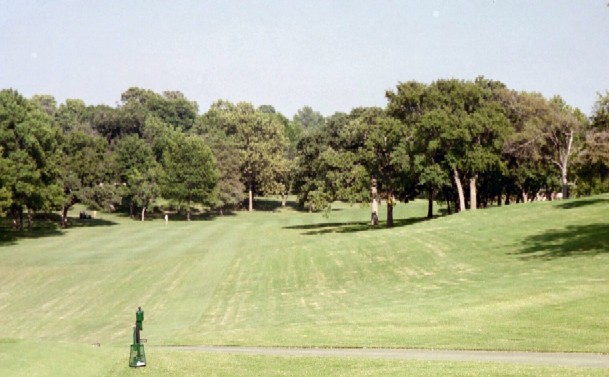
The topography at Southern Hills is excellent for golf and is highlighted by this view off the 10th tee.
Hole 11: 173 yards
Another of the famous Maxwell ‘template’ holes is the par three with an angled green, much like the 2nd at both Prairie Dunes and the 2nd at Old Town. These greens often appear to be among the most contoured on the course and this is no exception. The elevated tee provides an excellent view of the hole, as the tee shot appears to just hang in the air. The slope of the green from right to left also elegantly flows off of the hillside. This same hill has now been used by Maxwell on no less than five holes as the dominant elevation factor on the site. This use of the large ridge reminds one of the way Donald Ross used the large sand ridge at Seminole in routing that fine course.
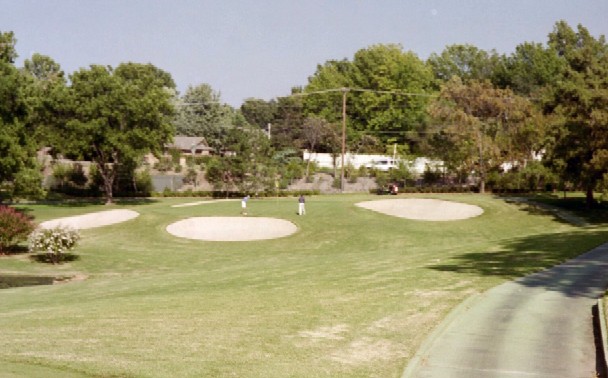
The well defended 11th green.
Hole 12: 458 yards
Almost every famous hole in the world is marked by fabled successes and failures. The 12th at Southern Hills is no different. This hole saw the fall of Arnold Palmer in the 1972 PGA, and was then heralded by him as one of the best par fours in the country. Ben Hogan claimed it to be the best 12th hole in the country. This all for a hole that almost wasn’t. If not for a suggestion to move the green to its current location it would have been located where the current 13th tee is located. From the tee this hole doesn’t appear to be much, but if the player clears the bunker on the corner of the dogleg then it becomes apparent what all the fuss is about. The green is protected by three large bunkers and a creek that runs from the pond back by the tee and crosses directly in front and presents a diagonal carry for most players. This inspiration is believed to have come from the 13th at Augusta National. Possibly, but Maxwell had not seen the hole at that point and it is unlikely he had discussed it with Alister MacKenzie as he had passed away by the time Maxwell began work at Southern Hills. The peril of the hole creates a major risk/reward option for the player as a chip from in front of the creek will almost guarantee a bogey, but those that chase glory and fall short are easily looking at a large number. The greatness of this hole is only tempered by the tree growth along the inside of the hole. Once the player clears the bunker they had best be on the right side of the hole as trees could dramatically affect the play from what was originally designed to be the preferred angle into the green.
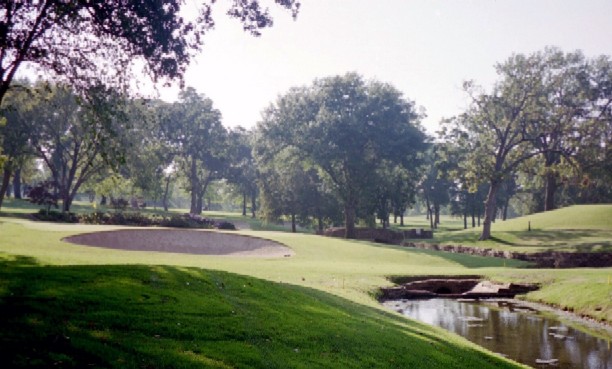
A big score can easily be had at the 12th.
Hole 13: 537 yards
The 13th was played in the 1958 Open as a long par 4 of 470 yards. It held the record for the most difficult hole in Open history until the mid 1990s when 480-yard par 4s became the norm. In later tournaments the tee was moved back to its true position and plays as a tantalizingly reachable par five. The terrain rolls significantly in the fairway and plays havoc on the lie for anyone who wants to attempt reaching the green in two. Two small ponds and bunkers surround the catcher mitt shaped green. The water found a victim in Tiger Woods, in 2001, when he tried to rally for the championship. The large roll in the middle of the green effectively segments the putting surface in two and makes any putts from the wrong side impossible and three putting likely. The entrance to the green is much tougher now than when the course originally opened as trees have somewhat throttled the entrance to the green. It does make for a tougher approach and presses the importance of playing from the middle of the fairway which is difficult on a fairway that rolls as much as the 13th.
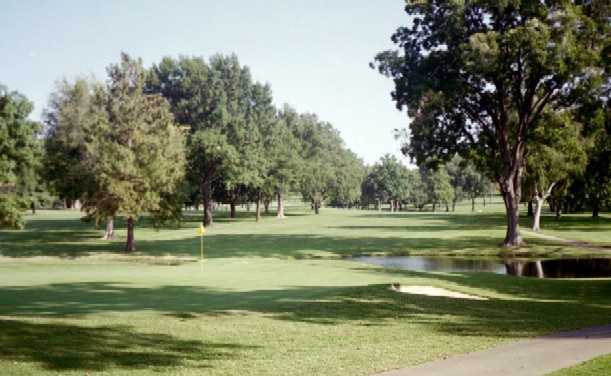
Looking back down the 13th.
Hole 14: 223 yards
The last in a surprisingly good quartet of par threes is this downhill monster. It is probably the most difficult. The tee has been moved slightly over the years back and to the left towards the fence that runs along the edge of the grounds. This creates an even more exacting shot into the green over the angled bunkers on the left side of the target. The green slopes from front to back and left to right in an arc like fashion. There is true joy in seeing a shot roll to the back right pin location.
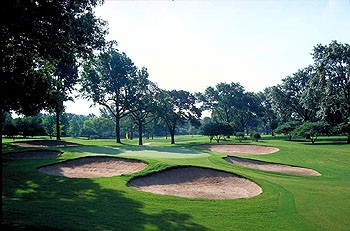
The 14th requires a well struck long iron to hold the putting surface.
Hole 15: 413 yards
This is often an overlooked hole on the backside of the course, but the mid-length par four is a pivotal hole in any round as it comes before the very difficult finishing three holes. The terrain on the hole slopes dramatically from left to right off of the bunker in the corner of the dogleg. The lie is often below the players feet while the green requires draw to really get back to any deep pin placements. A tree protects the left side of the green for anyone that tries to cut the hole too much. Short of the green is some excellent rolling terrain that makes any approach over the ground a tricky option at best. The slope of the green off of the knob to the right is the most severe on the backside, with the exception of the 18th.
Hole 16: 571 yards
The member tees on this hole are 80 yards farther back than the tournament tees on this hole. Also the par is one higher. The player also has a completely different view of the hole from these tees as they are elevated slightly above the tournament tees and the elevations in the fairway are much more obvious. The rolling nature of this hole immediately draws comparison to the 8th hole at Crystal Downs that Maxwell worked on earlier in the decade. The use of the dried out creek beds and the natural terrain make for a very difficult three shot hole. The green sloping from back to front and right to left also creates a difficult approach for anyone, even with a wedge in their hand. The famous pond short and left of the green is really only in play on the second from most players as a pulled or hooked shot could easily end up wet.
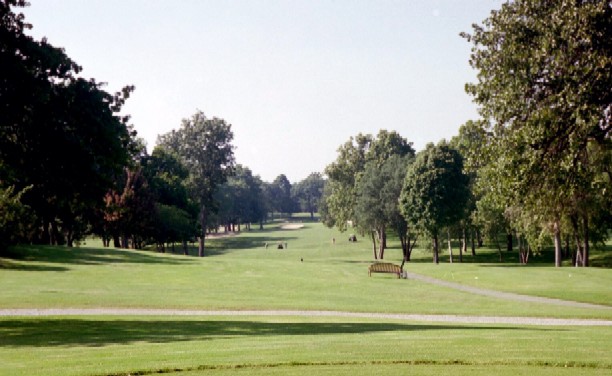
The view from the 16th tee highlights the terrain movement and the narrowness of the hole.
Hole 17: 358 yards
Perhaps this is the best hole on the course and it strikes a similar cord to another course with a Maxwell connection that features a shortish par four as the penultimate hole (Crystal Downs). The rolling terrain runs almost 10 feet down from left to right towards a creek that runs along the right side of the hole. Trees also run along the creek. All of this is key as the best approach angle into the unique green is from this side of the hole. Anyone not playing the slope of the terrain is bound for trouble. The longer hitter may hit to the left side of the fairway and land among the severe rolls or even below the putting surface with a difficult pitch to a green that slopes from right to left. The bunkering short of the green also creates the need to loft the ball into the target. The back left portion of the green was added by Floyd Farley in 1962 and is admittedly by the club, the only change to the course that Maxwell would not have approved. The author disagrees as the green contains some excellent contouring that Perry would surely have appreciated and is still a narrow target even if it has more length than many other holes of this length. Large greens produced at the Austin Country Club and other Maxwell courses also provide proof that this was not a totally disagreeable concept to the designer. This also is an example of trees altering the line of play, but this time it is due to an elimination of trees. Maxwell originally designed this hole to dogleg around a tree that protected the right side of the hole. The tree was eliminated fairly early on by the club. It is not known if it died from natural causes or from a late night raid by a frustrated member.
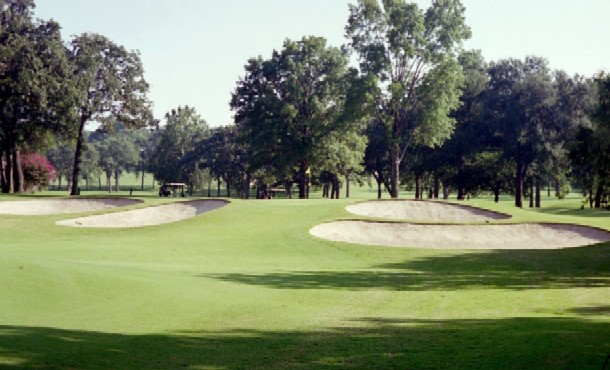
The hard to hit 17th green complex
Hole 18: 465 yards
The famous finishing hole saw perhaps the weirdest finish to a 72-hole tournament as two players missed par putts from within five feet on the last hole of the 2001 US Open forcing a two way playoff the following day. Eventually, Retief Goosen would win by dominating the playoff, but for one hole he clearly did not know the course and succumbed to the pressure of his first major win. The hole layout is simple enough with a slight dogleg, but the large drop at about 300 yards from the tee down to the creek creates a real danger for many longer players. The temptation, though, is that the most level lie on the hole is located at a narrow stretch just short of the creek. Either the player tries for the flat lie or is faced with an uphill approach with the ball below their feet. The first hole at Maxwell’s Old Town Club features a very similar hole design. The large bunker short and left of the green originally featured a grass mound in the middle of it, which the membership eventually eliminated because it involved too much ‘luck’ for their liking. But anything from the right side of the hole will need true luck if they want to attack the green as trees severly cut off anything from this side. The green is the most severe slope from back to front on the course and resulted in many fits in the 2001 Open due to the speed it was maintained for the tournament. This strong and difficult hole is often seen as one of the best finishers for any major championship course and rightly so.
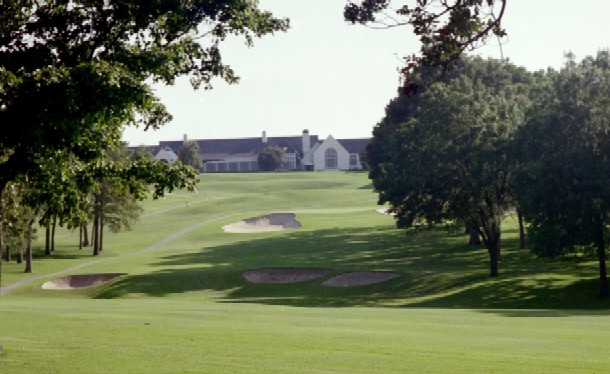
The approach to the 18th is rightly considered one of the game's hardest.
When maintained at everyday conditions the membership at Southern Hills clearly has access to one of the real jewels of American parkland golf but there are real causes for concern. Unfortunately, too many associate the course with six-inch rough that eats balls and the narrow fairways used for the major tournaments held at the site. This though is only the case when the big boys come to town. As of the 2001 US Open the course contained over 4,000 trees. The trees thus eliminate one of the main factors that Maxwell always accounted for in his designs, the wind. The other major impact is that what was originally designed as a 2nd shot course has now turned into a 1st shot course. If the player doesn’t have the tee shot in the correct side on many holes, they are automatically a half shot behind on the hole. This would be against much of what Maxwell intended for any of his designs. Though Southern Hills was intended to be a ‘championship’ test, it was not meant to take on the modern meaning of that term.
Aside from the tree issue, Southern Hills serves as a reminder of the philosophy of Maxwell that every site should have it’s own character as few things in Tulsa would make one think of the sand hills of Prairie Dunes or the heathland-like terrain of Crystal Downs, but the consistent traits between the three courses speak of Maxwell’s time spent on each of the sites to create equally great masterpieces. The site contains a solid variety of holes throughout, testing greens that require imagination to correctly approach them, strategic golf options from the tee and a solid routing that uses the natural features of the site in a varied manner. With the exceptions noted previously, the spirit of the Maxwell design is still intact and remains that way after nearly 70 years with only two significant architectural changes to it. It remains a light of what many consider the dark years after the much acclaimed ‘Golden Age of Golf Design.’
The End








